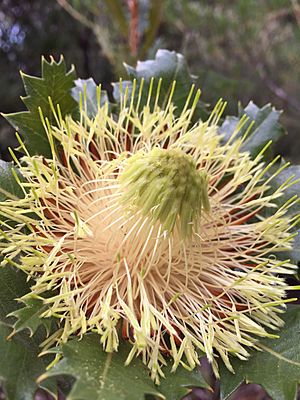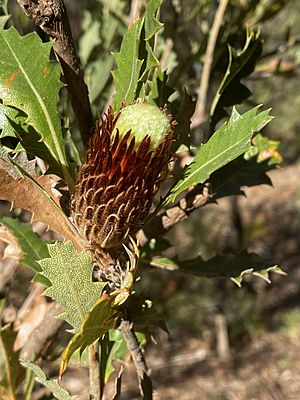Oak-leaved dryandra facts for kids
Quick facts for kids Oak-leaved dryandra |
|
|---|---|
 |
|
| Banksia heliantha in the ANBG | |
| Scientific classification | |
| Genus: |
Banksia
|
| Species: |
heliantha
|
| Synonyms | |
|
|
The oak-leaved dryandra (scientific name: Banksia heliantha) is a special kind of shrub. It grows only in Western Australia. This plant has fuzzy stems and leaves shaped like an egg or a wedge. Its leaves also have jagged edges, like a saw! When it blooms, you'll see beautiful golden-yellow flowers. After the flowers, it grows fuzzy, egg-shaped fruits called follicles.
Contents
What Does It Look Like?
The oak-leaved dryandra is a strong, bushy shrub. It usually grows between 0.6 and 3 meters (about 2 to 10 feet) tall. Its stems are covered in tiny hairs. Unlike some plants, it doesn't have a special woody base called a lignotuber that helps it regrow after a fire.
Leaves and Flowers
The leaves are shaped like a wedge or an egg, with the narrower part at the bottom. They are about 50 to 90 mm (2 to 3.5 inches) long and 22 to 50 mm (0.9 to 2 inches) wide. Each leaf sits on a short stem called a petiole, which is up to 10 mm (0.4 inches) long. The edges of the leaves have between five and fifteen sharp, pointed teeth on each side. These teeth can be up to 6 mm (0.2 inches) long.
The flowers grow in groups of 140 to 160. These groups form a head at the ends of the branches. At the base of each flower head, there are long, hairy, pointed leaves called involucral bracts, which can be up to 50 mm (2 inches) long.
The flowers themselves are golden yellow. Each flower has a part called a perianth, which is 35 to 41 mm (1.4 to 1.6 inches) long and hairy at its base. It also has a yellow pistil, which is the part that receives pollen. The pistil is 41 to 52 mm (1.6 to 2 inches) long and smooth.
When It Blooms and Its Fruits
The oak-leaved dryandra usually blooms in March or from July to October. After flowering, it produces egg-shaped fruits called follicles. These follicles are 15 to 20 mm (0.6 to 0.8 inches) long and are fuzzy on their top half. Each flower head can grow up to fifteen of these fuzzy follicles.
How It Got Its Name
This plant was first officially described in 1856 by a scientist named Carl Meissner. He named it Dryandra quercifolia. The second part of its old name, quercifolia, comes from a Latin word that means "oak-leaved." This is because its leaves look a bit like oak leaves.
Later, in 2007, two scientists, Austin Mast and Kevin Thiele, moved all the Dryandra species into the Banksia group. But there was already a different plant called Banksia quercifolia. So, to avoid confusion, the name of this dryandra was changed to Banksia heliantha. The new name, heliantha, comes from ancient Greek words meaning "sun-flowered," which fits its bright yellow blooms!
Where Does It Live?
The oak-leaved dryandra grows in dense kwongan, which is a type of shrubland found in Western Australia. It likes rocky hills near the south coast, between the Gairdner River and East Mount Barren. You can also find it further inland, in the ranges north of Ravensthorpe. These areas are part of the Esperance Plains and Mallee biogeographic regions.
Is It Safe?
The Government of Western Australia's Department of Parks and Wildlife has classified this banksia as "not threatened." This means that for now, there are enough of these plants, and they are not in danger of disappearing.


